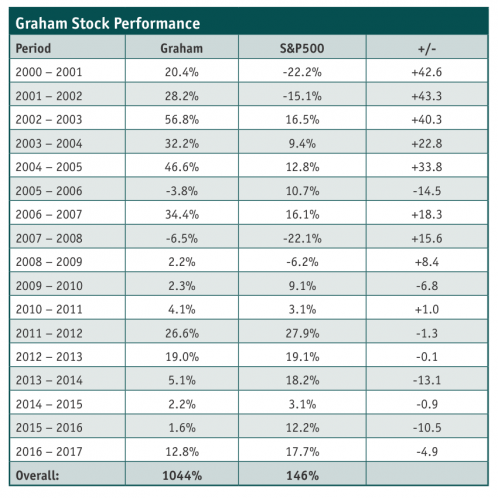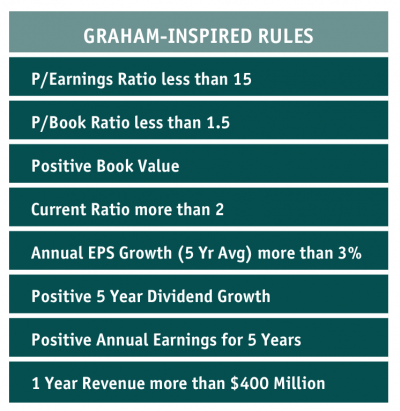Two Graham Stocks For 2018
 It’s time to harvest last year’s crop of Graham stocks and to plant a new one.
It’s time to harvest last year’s crop of Graham stocks and to plant a new one.
I’m pleased to say that my version of Benjamin Graham's method for defensive investors beat the market since it was launched way back in 2000. If you had purchased an equal dollar amount of each Graham stock in the first year and replaced them with the new crop of stocks each year thereafter, you would have grown $1,000 into $11,440. In comparison, $1,000 invested in an S&P 500 exchange traded fund (NYSE:SPY) would have grown to $2,460 over the same period. Translated into percentage terms, the Graham stocks gained 1044% (16% annualized) over the full period while the S&P 500 ETF moved up 146% (6% annualized).
I hasten to add that the Graham stocks didn't outperform each and every year. For instance, last year the Graham stocks gained 13% while the market climbed 18%. The Graham stocks lagged by five percentage points.
Unfortunately, poor relative performance is something that has to be expected from time to time. Indeed, despite its excellent long-term track record, the method trailed the market in eight of the last seventeen years and lost money twice.

The full record is shown in the accompanying table. The return figures are provided in U.S. dollar terms, reflect periods between data collection, and include dividends reinvested each year when the new stocks are selected. They do not include inflation, taxes, fees, or trading costs like commissions.
Benjamin Graham described his method for defensive investors in his book The Intelligent Investor, which should be on every investor's bookshelf. While the original is a little dated, the 2003 edition (ISBN 0060555661) has more modern commentary from veteran columnist Jason Zweig. Serious Graham buffs should also invest in a copy of the sixth edition of Security Analysis (ISBN 0071592539), which includes commentary from some of today’s most famous value investors. However, the second tome can be daunting for both new and old investors alike.

Mr. Graham’s original rules for defensive investors were very stringent. You’d have been hard pressed to find any North American stock that passed the test during the last two decades. That's why my version employs a slightly more lenient approach. The main criteria I use are summarized in the accompanying table.
For instance, I differ with Mr. Graham when it comes to dividends. He originally demanded a twenty-year record of uninterrupted dividend payments whereas I require some dividend growth over the last five years.
Even with my more relaxed requirements, very few U.S. stocks usually pass the test. At market lows, such as those seen in the spring of 2009, there might be dozens of defensive stocks. But in more normal times less than ten companies make the grade. In recent years the list contained two or three stocks.
Alas, the aging U.S. bull market cleaned out the value cupboard. No U.S. stock passed the test this year.

As a result, I was forced to consider a few different options. One option was to simply call it a day and end the Graham series of articles after a successful 17-year run. I was also tempted to loosen the criteria to highlight the best bargains in the market while departing more significantly from Graham’s original method.
But the series was saved by an unusual turn of events. I’ve been souring the Canadian market for defensive stocks for years and frequently came up empty handed. This year two Canadian stocks passed the defensive test. So, they’ll be highlighted this time around.
The two Canadian Graham stocks are shown in the table below. By way of full disclosure, I own a few shares of Exco Technologies. As it happens, the stock made its way into my Northern Dividends portfolio earlier this year.
I hasten to add that a well-diversified portfolio should contain at least ten stocks and usually many more. Holding a very concentrated portfolio is itself a source of risk. After all, a few individual disasters can really hurt in such cases. That's why it's best to add the defensive stocks to an already reasonably diversified portfolio.
As always, before buying any stock it is important to examine it in great detail. Dig through the numbers and consider the less tangible aspects of each company. Get up to speed by reading news stories about the company along with press releases and regulatory filings.
Dive in only after you've taken the time needed to become comfortable with the method and value investing more generally. Even when you do, I suggest starting off in a small way with a modest amount of capital because sticking with it through thick and thin can be harder than most investors expect. But I hope the method will reward investors over the long term.
Norman Rothery, PhD, CFA, Founder of StingyInvestor.com, Toronto, Ontario. Email: rothery@stingyinvestor.com. Visit www.stingyinvestor.com


